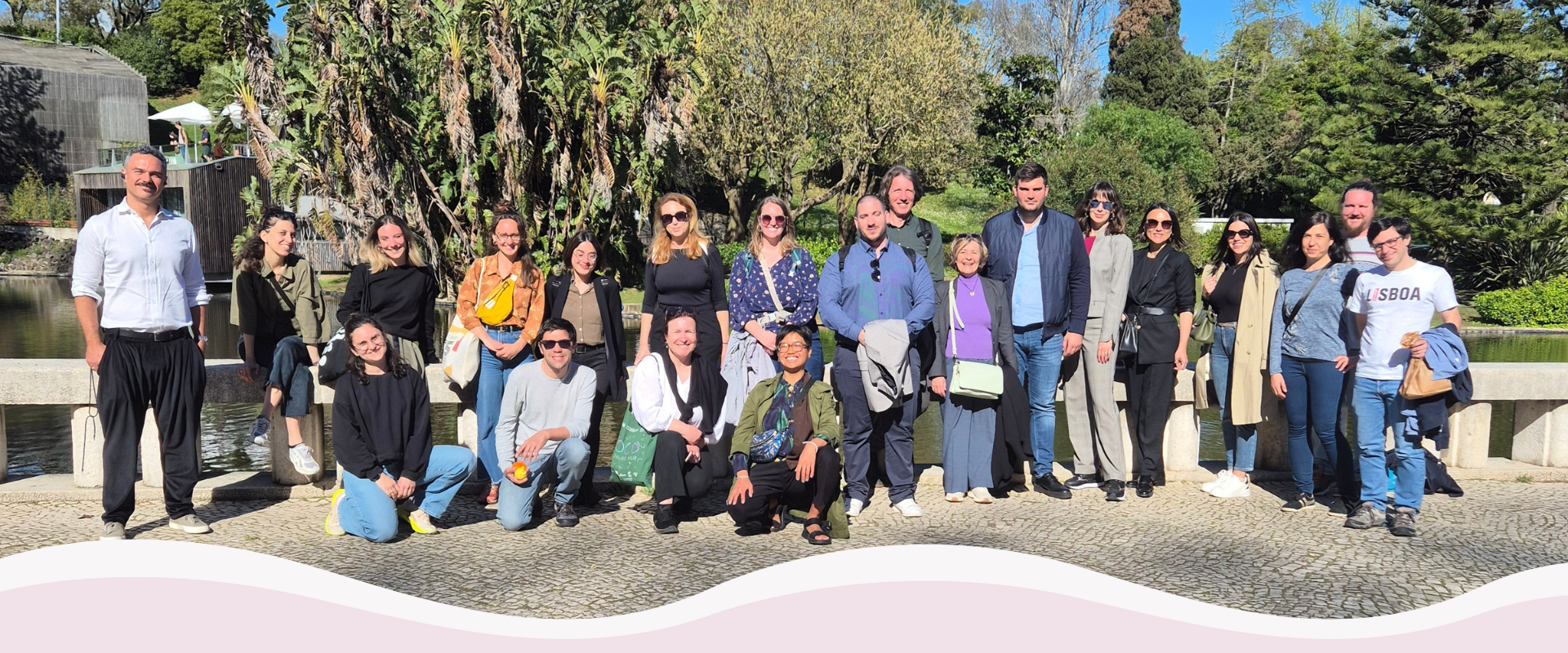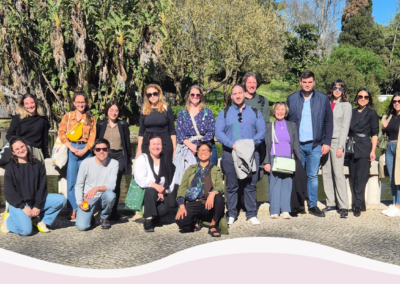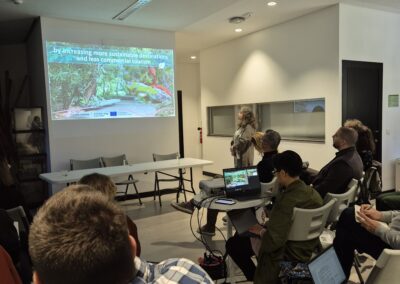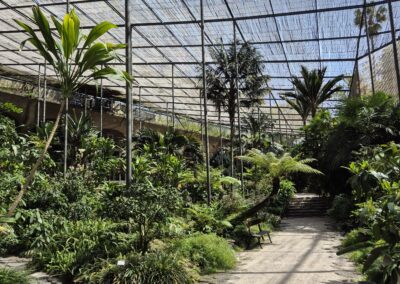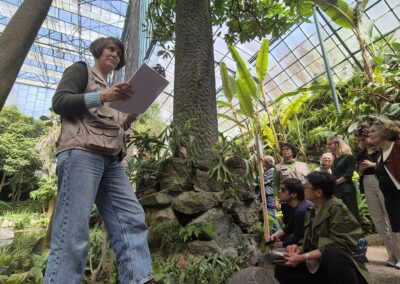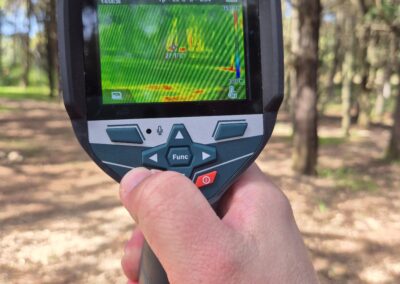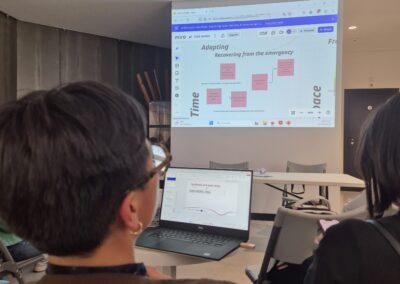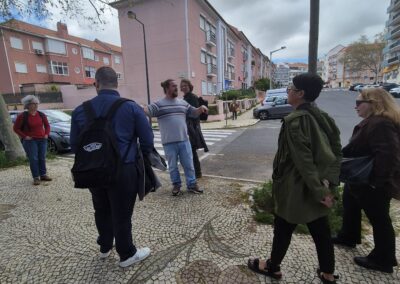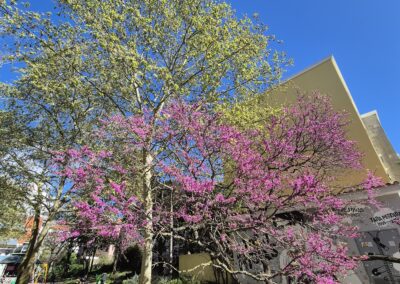Day One: Welcome to Lisbon
Maria Telhado (Municipality of Lisbon) + Marie Baduel (Director of strategy in AVITEM) welcomed the partners in Lisbon and officially open the second in-person Steering Committee – the first in-person Steering Committee was held in Marseille in March 2024, while all partner meet every month in online meetings.
In-person meetings are very important opportunities for the partners to get together, but in order to reduce the environmental impact of travelling from 6 different countries, Cool Noons chooses to have only one in-person meeting every year.
Marie Baduel from Avitem reminds the importance of the project in a moment where tourism is switching in order to improve the experience of the visitors, Cool Noons intersects with this “switch” by bringing the attention on Sustainability within tourism.
Maria Telhado explained how Lisbon plans to be carbon neutral by 2030, and Maria Telhado underlines how Cool Noons perfectly fits in the new management of improving tourism, by giving a renewed push in the direction of sustainability. She also quickly presented the program of the two-days Steering Committee, which involves workshops, panels and guided visits to Lisbon’s Cool Paths.
The urgency of taking action: Cool Noons project
Lu’u, from Avitem (lead partner of Cool Noons) after welcoming the partners in Lisbon presented and reminded the partner the background Cool Noons was born and develops in: a very specific moment in world history, where climate change and global warming are manifesting frequent heat waves, especially in Mediterranean areas. The urban centers of the Med-area share common features, such as urban heat islands and large urbanization – over 70% of the Mediterranean population lives in cities or towns.
Cool Noons project aims to tackle the effects of global warming in the Mediterranean cities, by providing framework for successful adaptation, to improve the visiting experience in urban centers: create and map Cool Paths in the 5 pilot cities, install and implement climate-mitigating solutions (nature-based, water based, etc) to create cooler areas in the cities, constitute guidelines for exporting the Cool Noons strategy in other cities.
Stefano Audifredi, Financial Manager of the project (Avitem), had an important presentation about reporting, bringing the attention to the responsibility of each partner also in the financial side of a European project such as Cool Noons. Being a cooperative project, the partners support in each other in every phase, which includes the financial report of investments and expenses.
Lu’u presented the content and workplan of Cool Noons, summing up what we have done and what we are looking forward to.
Tourists in Lisbon: Estufa Fria
In the afternoon, two activitity were planned: a visit to Estufa Fria and a walk on one of the Cool Paths of Lisbon.
Cool Noons partners had the honor of experiencing a guided visit to the Estufa Fria, the cold greenhouse of the city of Lisbon. This incredible space in the center of Lisbon hosts a collection of plant species from Southeast Asia, Oceania, South and Central America, making it a real botanical paradise where you can immerse yourself and forget about the buzz of the urban environment. Estufa Fria de Lisboa hosts also two “hot” greenhouses, one is more humid, the other is drier, to create the right environment for different cacti and euphorbias species. This facility is such a secret gem of Lisbon, supporting the education system by hosting schools and providing materials to the students and teachers of all grades; it also welcomes visitors from all over the world all year round. Find out more about Estufa Fria.
Lisbon’s Cool Path #1: Green Corridor Eduardo VII – Monsanto park
After this green experience, Cool Noons partners moved onto one of Lisbon’s Cool Path: a green corridor which connects Eduardo VII park (near Estufa Fria) to Monsanto Forest Park, a real forest in town! These two parks in the city provide a cool shelter from the heatwaves and hottest days in the Portuguese capital.
During the walk, the partners learnt about the mission leading the greening process of this path, which follows the criteria of biodiversity and soil restoration, featuring plant species from the North and South of Portugal, flowers to attract pollinators, almond and oak trees to attract squirrels and birds. The walk was also the chance to monitor the temperatures and test the thermal confort on the path, as well as take thermal photos in order to have a better understanding of the current enrironmental conditions. Thermal cameras showed a big difference between ground temperature on the sunny areas of the Path (around 30°C to 40° C) and the shade of Monsanto forest, where the ground temperature was lowered to 21°C!
The overall “thermal feedback” from the partners was a hot feeling while walking (and it was only the end of March!), but the cool of Monsanto forest was regenerating with the lower temperatures under the trees canopies.
Cool Noons partners ended the day with a lovely dinner near Praça do Comercio and are ready for the second and last day of the Lisbon meeting.
Day 2: In-room activities “Testing and Monitoring solutions for tourists and inhabitants”
The second day of the Steering Committee in Lisbon opened with a welcome from the Avitem team, before giving the floor to Luka Mihailovic (Budva), who presented the progress of the five pilot cities: focus groups, selected solution, data collection and timing of implementation of the Cool Paths solutions.
Maria Vrasida and Vasileios Vlaseros focused on the cross-cultural evaluation of Cool Noons: in order to have an objective measure of the results of the implemented solutions, Cool Noons must collect data, before and after the interventions. Some data are constituted by weather conditions, temperature, air humidity, but some are human-based feelings, such as perception of wellbeing, thermal comfort, satisfaction. University of Coimbra and the American College of Greece are two important academic institutions, which represent a very precious resource for the consortium: their scientific approach and precise methodology provide a strong framework on how to collect data and how to analize them.
A focus on Communication
A wide overlook about Communication was given by communicatio officer Agnese Comissari (Imola Faenza Tourism Company), who summed up the processes for approval and production of promotional goodies, stimulated the partners in involving media and press in the local promotion of the Cool Paths as a tool for tourism promotion. Agnese also presented the next steps of Cool Noons communication: the online catalogue of the selected solutions, the videos and the online photo contest.
Spotlight on the Associated Partners and synthesis of the Steering Committee
The following scheduled activity involved the Associated Partners who took the opportunity of working with the partners during the Steerin Committee. Joao Mourato introduced the Associated partners for the panel “Mediterranean Sustainable Tourism”: Rita Alameida of Turismo de Lisboa, Juliana Antic Brautovic of City of Dubrovnik, Julia Pierraccini of MedCities Mediterranean City Network and Luka who presented the Tourism organization of Budva.
The Associated Partners of Cool Noons have an important role in supporting the evolution of the project, helping in disseminating the results and the good practices developed in the many phases. Each of them presented an insigth of their key features, their role in the local growth, as well as interesting points of view on both Tourism and Sustainability.
Lisbon’s Cool Path #2: Alvalade
After the lunch break, Cool Noons’ project manager Lu’u Dauxais presented a sythesis of the meeting. After this important moment to wrap up the event, the Partners moved to the streets of Alvalade, to explore Lisbon’s Cool Path #2.
This itinerary develops in a residential neighbourhood, where the citizens took the opportunity of using small pieces of land (officially owned by the parish) in front or in the back of the houses: the result is a small urban jungle, made up of lemon trees and blossoming Judas trees, strelitzia flowers and incredible scents all over the air.
The path also features a rare example of policromatic calçada portuguesa (Portuguese pavement) and meets some of the “lojas com historia” (Historical shops) that once were all over Lisbon, but in this neighbourhood are still present, such as “A Mariazinha” and the Mercado de Alvalade Norte.
The itinerary moves, for a short part, on the Avenida de Roma right by the Monumento a Santo Antonio, one of the patron Saint of Lisbon: on this Avenue, oriented North-South can benefit from the refreshing winds that cross the city of Lisbon from North to South, provinding a natural relief from the heat of summer. For this reason, alongside the idea of inviting visitors in a new area of the city which features art galleries, ateliers and numerous green spaces, Alvalade was chosen for hosting one of the Cool Paths in Lisbon.
Also during this itinerary, the University of Coimbra coordinated a data-collection session, to monitor air and ground temperatures and humidity.
Closing of the Steering Committee
Lisbon Steering Committee was a valuable experience for the partners, who got to exchange ideas and feedbacks, spend time together as a team and also had the chance to experience in person what is feels being a tourist in Lisbon. The events and the activities were very well organized and appreciated, thanks to the great Lisbon team.

